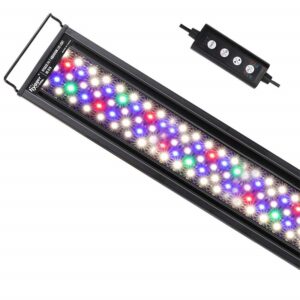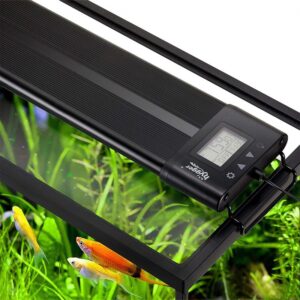Light is vital for the photosynthesis of aquatic plants. Without sufficient light, the colors of chromatic plants will be less brilliant, while some plants even change the morphology of their leaves to get more light. In the following sections, we will get into a deeper learning of LED grow lights for plants, like the PUR values and the suitable LED lighting for plants to grow, etc. OK, rant over, let’s get down to business.
Content Table
What does PAR mean in lighting
What is PAR? It is a parameter to measure the amount of light for photosynthesis. Its full name is Photosynthetically Active Radiation. You can measure it with a PAR meter. In general, plants photosynthesize through visible light, which wavelength ranges from 380 nm to 750 nm. However, the available PAR of plants is usually between 400 nm and 700 nm. Also, PAR is quantified by the Photosynthetic Photon Flux Density (abbreviated in PPFD) in the unit of μmol/s.
Besides that, the light you provide should be sufficient to reach the bottom of the tank. For aquatic plants, what is considered low, medium, and high light may vary for different aquarium hobbyists. The PAR range coincides with high, medium, and low light is still a bit indeterminate.
“I know 20 is good enough low light to grow plants without CO2, but not at all fast. With CO2, it is enough to grow plants reasonably fast. 40 is low-medium light, where almost anything will grow if you have good CO2. Above 50 or so, will become an algae heaven if you don’t use high concentrations and steady concentrations of CO2, so that must be highlighted.” Said Hoppy, who likes to share all the thoughts and insight into the planted tank hobby from the plantedtank.net forum.
Next, we will share the PAR requirements for some aquatic plants, and take it as a reference.
| Types of aquatic plants | PAR values |
| Low light plants (e.g. Moss, Java fern, Anubias) |
10-50 μmol/s |
| Medium-light plants (e.g. Red flame sword, Micro sword, Pearl weed) |
50-120 μmol/s |
| High light plants (e.g. red or colored aquatic plants) |
120-200 μmol/s |
PUR in aquarium lighting
PUR stands for Photosynthetically Usable Radiation. It measures the quality of light per application. In other words, it means the light energy used by aquatic pets or plants. Specifically, PUR is the usable part of PAR. Consequently, the PUR value is different from various photosynthetic species.

Best LED light for growing plants
As we have mentioned above, there are low-light, medium-light, and high-light aquatic plants. Then, what are the LED lights to grow plants? Just continue reading. You will get some ideas from this part.
For example, you can know the perceived color from the Kelvin rating of the light. Generally, a Kelvin rating of 3000 or below will appear yellow, and a Kelvin rating of about 6000 will emit white, while a higher Kelvin rating will be blue. Consequently, if you have a coral reef tank, an aquarium light with a higher Kelvin rating should be your excellent alternative.
Besides that, the available PAR of plants is usually between 400 nm and 700 nm. This is the light for plants that can be used for photosynthesis. Commonly, red, green, and blue light is used the most by aquatic plants. Accordingly, the ideal light spectrum for freshwater aquatic plants should be:
- The wavelength range of 630-700 nm: at least 50 percent of red light
- Wavelength range of 500-580 nm: at least 35 percent of green light
- The wavelength range of 435-495 nm: less than 15 percent of blue light
Additionally, here are some recommendations for the best LED grow lights for plants:
| Tank size and types of aquatic plants | Recommended LED light | Advantages of the LED light |
| 20-gallon tank with low-light plants | Clip-on LED Aquarium Light |
|
| 12 inches long tank with low-light plants | Planted Aquarium LED Light |
|
| 40 inches tank with low-light and medium-light plants | Aquarium Red Blue White Light |
|
How long should plants be under LED grow lights
Should you keep the LED light on day and night? Actually, no. The types of aquatic plants should determine the lighting hours. Otherwise, too much light will lead to algae thriving, which may be a threat to plant growth Or even be damaging to fish. Because some algae are harmful to your aquarium, like blue-green algae, green dust algae, and black beard algae.

So, how to set lighting hours for plants in your tank? You should know the ideal lighting hours for your aquatic plants. Usually, you should keep the light on for about 8–10 hours each day for low-light plants, while medium-light plants require about 10 hours of light each day. And high light plants may need about 10–12 hours of light per day. By the way, most plants may need a dark environment, which usually should be about 8 hours. During this time, plants will consume oxygen but release carbon dioxide. Consequently, you can do with low light + CO2 for your planted tank.
For instance, provided that you have a planted tank with low-light plants, you can keep your light on for 8 hours. However, in the case of algae thriving, you can decrease the lighting hours accordingly, like 6 hours. If it is no use to shorten the lighting hours, you can introduce some algae eaters to deal with the issue, such as nerite snails and Amano shrimp.
Tips and related topics
Tips
To conclude, here is a summary of some light parameters.
- PAR: Photosynthetically Active Radiation measures the amount of light for photosynthesis.
- PUR: Photosynthetically Usable Radiation measures useful light energy.
- PPFD: Photosynthetic Photon Flux Density quantifies the PAR value.
- PAS: Photosynthetic Action Spectrum refers to the relationship between the rate of physiological activity and the wavelength of light.
- Watts: Measure the amount of energy.
- Kelvin: Describe the color temperature of light.
- Lumen: Measure the level of light brightness (light intensity).
Related topics
By the way, if you want to learn more about LED lighting for plants to grow, you can read the following articles:
For more additional ideas about aquarium light for plants to grow, please feel free to share them with us in the comments. We’re happy to receive your sharing and suggestions. Finally, thanks for your time and we hope this article helps.


Leave a comment